(完整版)新概念2语法分布表
- 格式:doc
- 大小:15.68 KB
- 文档页数:3
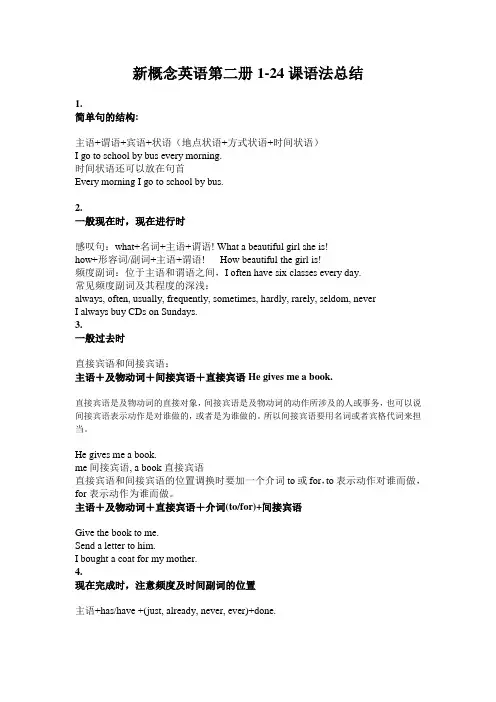
新概念英语第二册1-24课语法总结1.简单句的结构:主语+谓语+宾语+状语(地点状语+方式状语+时间状语)I go to school by bus every morning.时间状语还可以放在句首Every morning I go to school by bus.2.一般现在时,现在进行时感叹句:what+名词+主语+谓语! What a beautiful girl she is!how+形容词/副词+主语+谓语! How beautiful the girl is!频度副词:位于主语和谓语之间,I often have six classes every day.常见频度副词及其程度的深浅:always, often, usually, frequently, sometimes, hardly, rarely, seldom, neverI always buy CDs on Sundays.3.一般过去时直接宾语和间接宾语:主语+及物动词+间接宾语+直接宾语He gives me a book.直接宾语是及物动词的直接对象,间接宾语是及物动词的动作所涉及的人或事务,也可以说间接宾语表示动作是对谁做的,或者是为谁做的。
所以间接宾语要用名词或者宾格代词来担当。
He gives me a book.me间接宾语, a book直接宾语直接宾语和间接宾语的位置调换时要加一个介词to或for,to表示动作对谁而做,for表示动作为谁而做。
主语+及物动词+直接宾语+介词(to/for)+间接宾语Give the book to me.Send a letter to him.I bought a coat for my mother.4.现在完成时,注意频度及时间副词的位置主语+has/have +(just, already, never, ever)+done.I have just graduated from Yincheng Primary school.5.复习:一般过去时与现在完成时的区别主语+did sth+过去的时间状语.I went to Xuanwu Lake Park three days ago.主语+has/havedone+yet/since/for/so far.I have just been to Beijing.in the way/on the way/in this way/by the way/in a way/get out of my way/Don’t stand in my way./by the way/no wayspare/to spare6.冠词用法(一)1.不定冠词用于修饰单数可数名词,当一个单词的第一个发音为元音时要用冠词an, 如果是辅音用a即可。
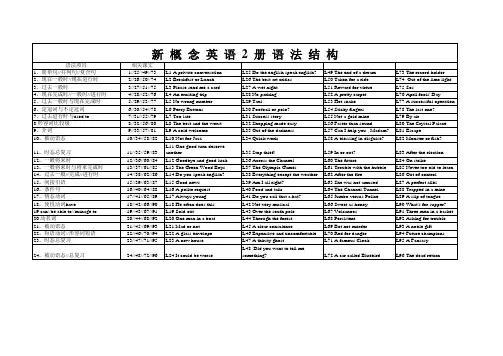

1简单陈述句语序25并列句中语序49复合句的语序73复习 KS 21,25,49(简单句,并列句和复合句) 2现在和经常发生的动作26经常发生的事情50表示习惯性动作74现在进行时和一般现在时3一般过去时27一般过去时51一般过去时75一般过去时4现在完成时28现在完成时52现在完成时,现在完成进行时76现在完成时与现在完成进行时5一般过去时和现在完成时29一般过去时和现在完成时的对比53一般过去时,现在完成时和现在完成进行时77一般过去时,现在完成时,现在完成进行时6冠词The & Some30冠词The,Some & Any54A, The,Some & Any78冠词A & The7过去进行时31过去进行时和一般过去时(used to)55表示过去习惯性动作(used to, would)79过去发生,过去政治进行和过去经常发生的动作8比较级32表示比较的词组56表示比较的词组80形容词和副词的比较级和最高级9时间短语中的介词( at, in, on, from…until, during, until)33动词短语中的介词(to, from, into, out of, for,towards,at)57At, In, Off & With81复习KS 9,33,57 (At, In, To, With, etc.)10(一般过去时中的)被动语态34被动语态58被动语态82复习 KS 10,34,58 11复习KS 2--1035复习KS 26--3459复习KS 50--5883复习KS 74--82 12一般将来时36将来时60表示将要发生的事84一般将来时13将来进行时37将来完成时61将来完成时,将来进行时和将来完成进行时85复习 KS 13,37,61(一般将来时,将来进行时,将来完成进行时)14过去完成时38过去完成时62过去完成时和过去完成进行时86过去完成时与过去完成进行时15间接引语39直接引语和间接引语63间接引语87间接引语16IF引导的条件句40非真实条件句64真实和非真实条件句88复习KS 16,40,6417情态动词Must41情态动词Must,Have to & Need65Must, Have to, Should & Ought to89情态动词Must, Have to, Need & Should 18Have的用法42Have的用法66Have的用法90Have的用法19Can& May43Can & Be able to67Can, Be able to & Manage to91Can, Be able to &Manage to20动名词44动名词68动名词92复习 KS20,44,6821被动语态45复习KS 10,21,34:关键语态69被动语态93复习KS 21,45,6922可跟of,from,in和on的动词46可与to,at,for 和with连用的动词70与for, with, of, to, at, from, in, on & about连用的词94复习 KS 22,46,7023复习KS 12--2147复习KS 36--4571复习KS 60--6995复习 KS 84,94 24复习SD 2--2348复习SD 26--4772复习SD 50--7196复习 SD 73-95新概念英语第二册的结构图第一单元第二单元第三单元第四单元。
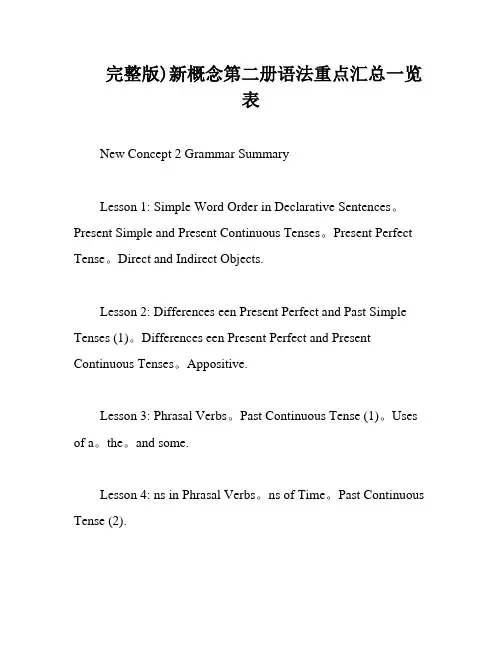
完整版)新概念第二册语法重点汇总一览表New Concept 2 Grammar SummaryLesson 1: Simple Word Order in Declarative Sentences。
Present Simple and Present Continuous Tenses。
Present Perfect Tense。
Direct and Indirect Objects.Lesson 2: Differences een Present Perfect and Past Simple Tenses (1)。
Differences een Present Perfect and Present Continuous Tenses。
Appositive.Lesson 3: Phrasal Verbs。
Past Continuous Tense (1)。
Uses of a。
the。
and some.Lesson 4: ns in Phrasal Verbs。
ns of Time。
Past Continuous Tense (2).Lesson 5: Comparatives and Superlatives of Adjectives and Adverbs。
Passive Voice。
XXX: in。
on。
at。
during。
till。
and until。
Two Forms of Negative Sentences: not any and no.Lesson 6: Passive Voice in Present and Past Continuous Tenses。
Double Possessive.Lesson 7: XXX with to。
Future Simple Tense。
Future Continuous Tense.Lesson 8: Past Perfect Tense。
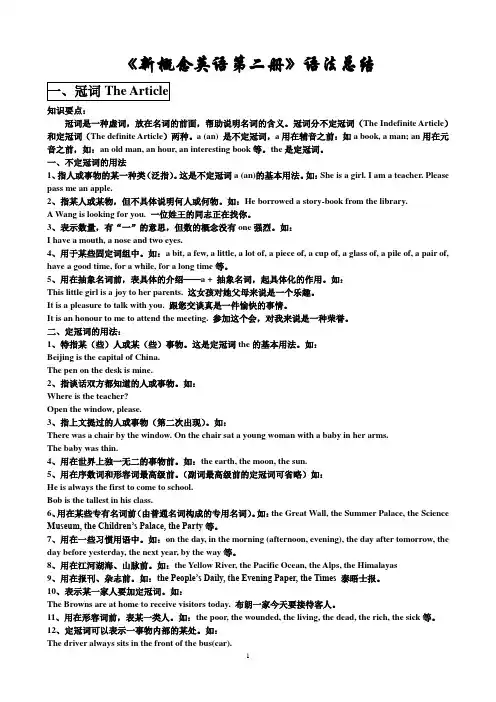
《新概念英语第二册》语法总结知识要点:冠词是一种虚词,放在名词的前面,帮助说明名词的含义。
冠词分不定冠词(The Indefinite Article)和定冠词(The definite Article)两种。
a (an) 是不定冠词,a用在辅音之前:如a book, a man; an用在元音之前,如:an old man, an hour, an interesting book等。
the是定冠词。
一、不定冠词的用法1、指人或事物的某一种类(泛指)。
这是不定冠词a (an)的基本用法。
如:She is a girl. I am a teacher. Please pass me an apple.2、指某人或某物,但不具体说明何人或何物。
如:He borrowed a story-book from the library.A Wang is looking for you. 一位姓王的同志正在找你。
3、表示数量,有“一”的意思,但数的概念没有one强烈。
如:I have a mouth, a nose and two eyes.4、用于某些固定词组中。
如:a bit, a few, a little, a lot of, a piece of, a cup of, a glass of, a pile of, a pair of, have a good time, for a while, for a long time等。
5、用在抽象名词前,表具体的介绍——a + 抽象名词,起具体化的作用。
如:This little girl is a joy to her parents. 这女孩对她父母来说是一个乐趣。
It is a pleasure to talk with you. 跟您交谈真是一件愉快的事情。
It is an honour to me to attend the meeting. 参加这个会,对我来说是一种荣誉。
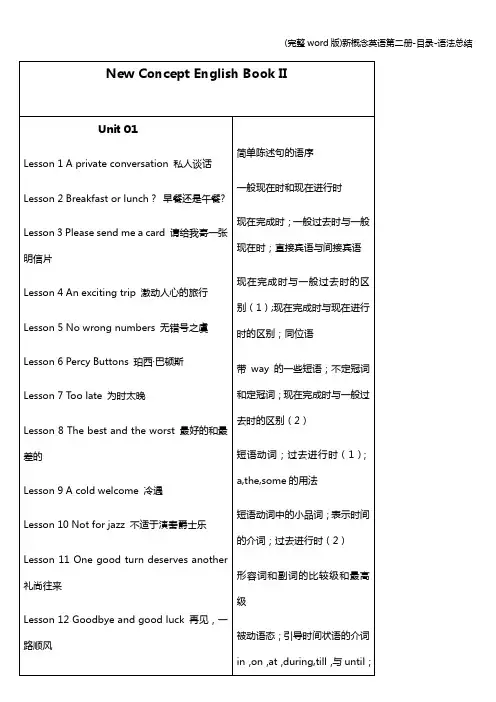
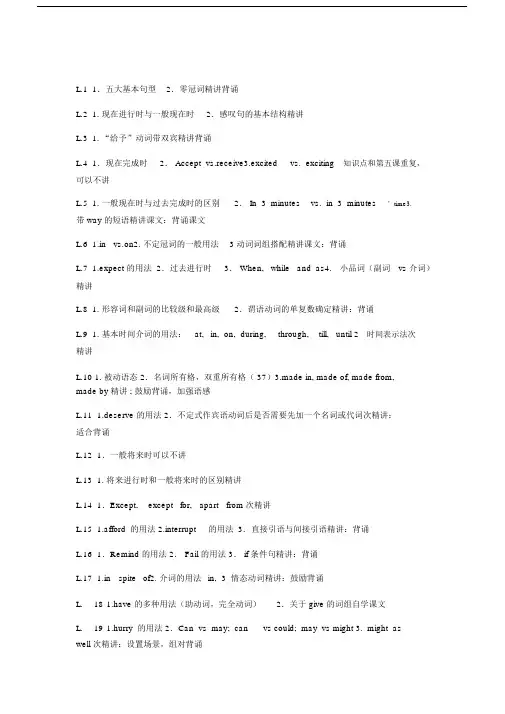
L.1 1.五大基本句型2.零冠词精讲背诵L.2 1. 现在进行时与一般现在时2.感叹句的基本结构精讲L.3 1. “给予”动词带双宾精讲背诵L.4 1.现在完成时2. Accept vs.receive3.excited vs. exciting知识点和第五课重复,可以不讲L.5 1. 一般现在时与过去完成时的区别2. In 3 minutes vs. in 3 minutes’time3.带 way 的短语精讲课文:背诵课文L.6 1.in vs.on2. 不定冠词的一般用法 3 动词词组搭配精讲课文:背诵L.7 1.expect 的用法 2.过去进行时3. When, while and as4.小品词(副词vs 介词)精讲L.8 1. 形容词和副词的比较级和最高级2.谓语动词的单复数确定精讲:背诵L.9 1. 基本时间介词的用法:at, in, on, during, through, till, until 2时间表示法次精讲L.10 1. 被动语态 2.名词所有格,双重所有格( 37)3.made in, made of, made from,made by 精讲 ; 鼓励背诵,加强语感L.11 1.deserve 的用法 2.不定式作宾语动词后是否需要先加一个名词或代词次精讲:适合背诵L.12 1.一般将来时可以不讲L.13 1. 将来进行时和一般将来时的区别精讲L.14 1.Except, except for, apart from 次精讲L.15 1.afford 的用法 2.interrupt的用法3.直接引语与间接引语精讲:背诵L.16 1.Remind 的用法 2. Fail 的用法 3. if 条件句精讲:背诵L.17 1.in spite of2. 介词的用法in, 3 情态动词精讲:鼓励背诵L. 18 1.have 的多种用法(助动词,完全动词)2.关于 give 的词组自学课文L. 19 1.hurry 的用法 2.Can vs may; can vs could; may vs might 3. might aswell 次精讲:设置场景,组对背诵L.20 1. 名充当主和2. Instead of vs. instead 精:背L.21 1. 含助的被2.Come into3.drive的不同用法4. Home vs. house 次精L.22 1 后介搭配文章次精L.23 1.there is vs. it is 自学文L.24 1 复,主要是后次精:鼓励背L.25 1 并列句or/either⋯or⋯ /neither反⋯意norbut/yet⋯推so/thus原因for 精:背L.26 1.pretend的用法2.Appreciate的用法3.Hang的用法4.哪些不适用于行次精:鼓励背L.27 1. 关于 put 的 2 and 引的并列句次精L.28 1. 在完成(在完成+since/ever since; 最高句 + 在完成; havebeen to vs. have gone to )2 it is one of the ugLiest faces I have ever seen 次精:在完成L.29 1 called 初步引定从句省略 2 the most surprising thing about it isthat ⋯表从句精:背文L.30 1.towards 的用法 2.定冠的用法 3 there were some people doing sth. 4so ⋯ that 次⋯精L.31 ed to do/be used to/get used to 2 去完成,去行精文:鼓励背,加感L.32 1.形容同比( as ⋯ as), than usual 2 一段之后,生另外一件事。
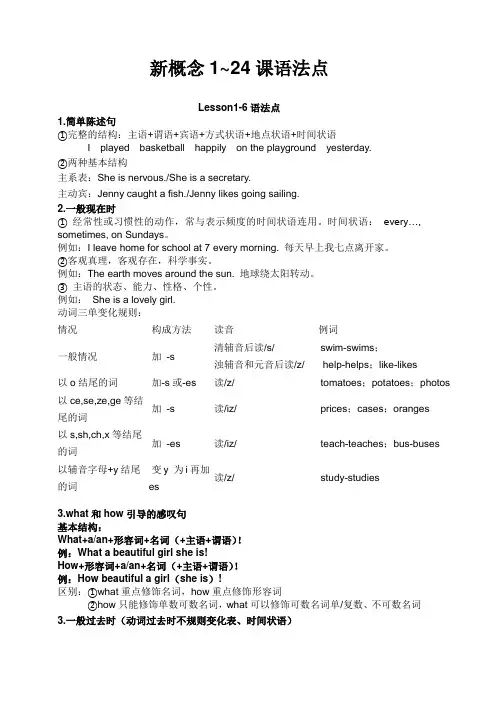
新概念1~24课语法点Lesson1-6语法点1.简单陈述句①完整的结构:主语+谓语+宾语+方式状语+地点状语+时间状语I played basketball happily on the playground yesterday.②两种基本结构主系表:She is nervous./She is a secretary.主动宾:Jenny caught a fish./Jenny likes going sailing.2.一般现在时①经常性或习惯性的动作,常与表示频度的时间状语连用。
时间状语:every…, sometimes, on Sundays。
例如:I leave home for school at 7 every morning. 每天早上我七点离开家。
②客观真理,客观存在,科学事实。
例如:The earth moves around the sun. 地球绕太阳转动。
③主语的状态、能力、性格、个性。
例如:She is a lovely girl.动词三单变化规则:情况构成方法读音例词一般情况加-s 清辅音后读/s/浊辅音和元音后读/z/swim-swims;help-helps;like-likes以o结尾的词加-s或-es 读/z/ tomatoes;potatoes;photos 以ce,se,ze,ge等结尾的词加-s 读/iz/ prices;cases;oranges以s,sh,ch,x等结尾的词加-es 读/iz/ teach-teaches;bus-buses以辅音字母+y结尾的词变y 为i再加es读/z/ study-studies3.what和how引导的感叹句基本结构:What+a/an+形容词+名词(+主语+谓语)!例:What a beautiful girl she is!How+形容词+a/an+名词(+主语+谓语)!例:How beautiful a girl(she is)!区别:①what重点修饰名词,how重点修饰形容词②how只能修饰单数可数名词,what可以修饰可数名词单/复数、不可数名词3.一般过去时(动词过去时不规则变化表、时间状语)一般过去时由动词的过去式表示,表示过去发生的动作或状态。
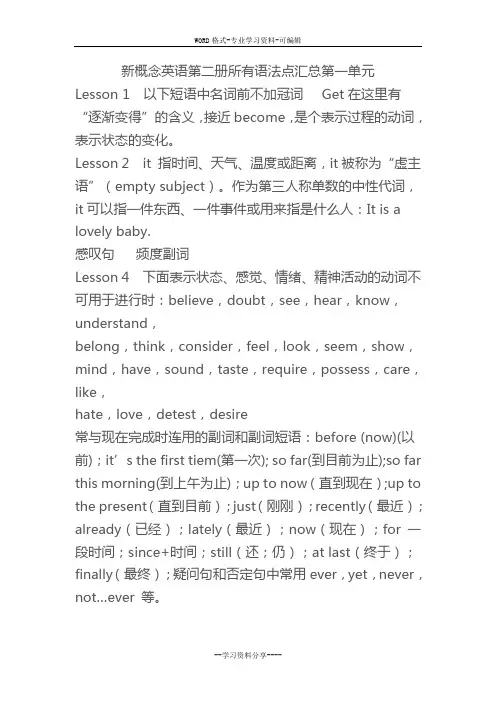
新概念英语第二册所有语法点汇总第一单元Lesson 1 以下短语中名词前不加冠词 Get在这里有“逐渐变得”的含义,接近become,是个表示过程的动词,表示状态的变化。
Lesson 2 it 指时间、天气、温度或距离,it被称为“虚主语”(empty subject)。
作为第三人称单数的中性代词,it可以指一件东西、一件事件或用来指是什么人:It is a lovely baby.感叹句频度副词Lesson 4 下面表示状态、感觉、情绪、精神活动的动词不可用于进行时:believe,doubt,see,hear,know,understand,belong,think,consider,feel,look,seem,show,mind,have,sound,taste,require,possess,care,like,hate,love,detest,desire常与现在完成时连用的副词和副词短语:before (now)(以前);it’s the first tiem(第一次); so far(到目前为止);so far this morning(到上午为止);up to now(直到现在);up to the present(直到目前);just(刚刚);recently(最近);already(已经);lately(最近);now(现在);for 一段时间;since+时间;still(还;仍);at last(终于);finally(最终);疑问句和否定句中常用ever,yet,never,not…ever 等。
现在完成时还可和表示频度的副词连用,表示反复和习惯性动作,如often(经常),frequently(屡次),three times(三次)等。
Lesson 5 up to now =up till now 到目前为止,到现在为止(作时间状语,时态多用现在完成时,相当于until/till now)a great many(+可数名词复数) 许多……, 相当于a great number of(+可数名词复数) 许多……可以做形容词短语:A great many trees were destroyed in the storm.也可作代词短语:He has read a great many of the books in this room.Lesson 7 main adj. 主要的(不能与人连用)all 一般直接加表示时间的单数名词构成副词短语,如:all day,all night,all week,all winter,all year等。
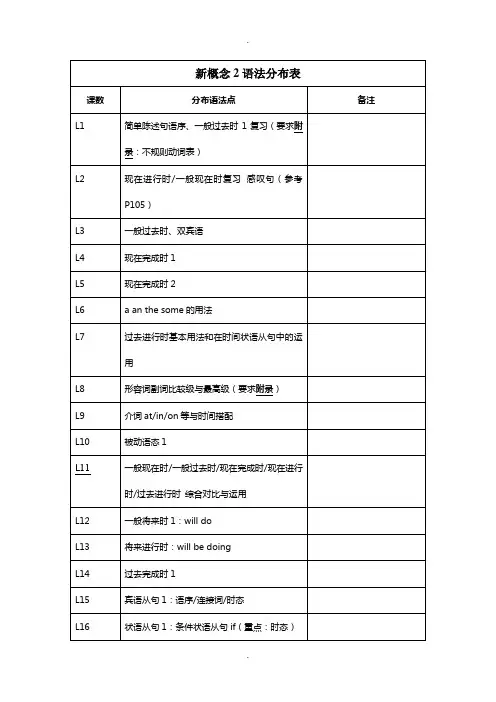
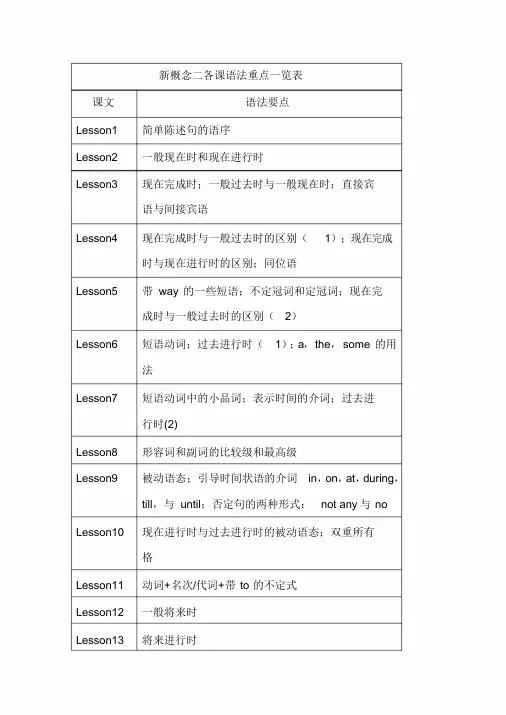
新概念二各课语法重点一览表课文语法要点Lesson1 简单陈述句的语序Lesson2 一般现在时和现在进行时Lesson3 现在完成时;一般过去时与一般现在时;直接宾语与间接宾语Lesson4 现在完成时与一般过去时的区别(1);现在完成时与现在进行时的区别;同位语Lesson5 带way 的一些短语;不定冠词和定冠词;现在完成时与一般过去时的区别(2)Lesson6 短语动词;过去进行时(1);a,the,some 的用法Lesson7 短语动词中的小品词;表示时间的介词;过去进行时(2)Lesson8 形容词和副词的比较级和最高级Lesson9 被动语态;引导时间状语的介词in,on,at,during,till,与until;否定句的两种形式:not any与no Lesson10 现在进行时与过去进行时的被动语态;双重所有格Lesson11 动词+名次/代词+带to 的不定式Lesson12 一般将来时Lesson13 将来进行时Lesson14 过去完成时Lesson15 直接引语和间接引语Lesson16 条件句(1)Lesson17 Must,have to,与have got to的用法Lesson18 实义动词have的用法Lesson19 表示许可的can和mayLesson20 介词与动名词Lesson21 情态动词在被动语态中的应用Lesson22 一些常见的动词词组Lesson23 There is 和it is 的用法Lesson24 无语法重点注重复习Lesson25 并列句的语序Lesson26 一般现在时与现在进行时的动词使用Lesson27 表示过去习惯动作的used to 和一般过去时的特殊用法Lesson28 现在完成时与since;关系从句及关系代词Lesson29 现在完成时与一般过去时的区别Lesson30 定冠词the的用法;some与any的区别Lesson31 过去进行时与一般过去时;use to的用法Lesson32 比较结构表示法;Little 和few 的用法Lesson33 用于表示目的和方向的介词和副词Lesson34 被动语态用法补充Lesson35 复习,本课无新的语法点Lesson36 Will 和be going toLesson37 一般将来完成时;将来完成进行时Lesson38 过去完成时与从属连词when,before,after,until Lesson39 间接引语中的say,tell,ask;间接一般疑问句;间接疑问词疑问句Lesson40 条件句(2)Lesson41 Must 的用法;have to的用法;need的用法Lesson42 Have+名词代替普通动词Lesson43 Can的用法;be able to的用法Lesson44 动名词与不定式;介词by 与with 的用法Lesson45 被动语态中的by 词组的使用Lesson46 动词与介词to,at,for,with 的搭配Lesson47-4无新重点内容,加强复习8Lesson49 复合句的语序Lesson50 动态动词和表态动词Lesson51 一般过去时Lesson52 现在完成时和现在完成进行时Lesson53 一般过去时,现在完成时与现在完成进行时Lesson54 A 与someLesson55 Used to 和wouldLesson56 比较结构的修饰语;the same as的比较结构Lesson57 用于描写任务的介词in 和with;表示地点与位置的介词与副词in,at,offLesson58 由get与过去分词构成的被动语态;it is said that 结构Lesson59 表示目的的几种方式:to,in order to,so as to,so that,in order thatLesson60 现在进行时表示将要发生的事Lesson61 It is the first time that 结构Lesson62 过去完成时复习;过去完成进行时Lesson63 祈使句的间接引语Lesson64 条件句(3)Lesson65 表示“应该”与“必须”的情态助动词must,have to,should 和ought toLesson66 使役动词have的用法Lesson67 Can,be able to,和manage to的比较Lesson68 动词与动名词Lesson69 被动语态中的动词词组;不定时的被动语态;现在分词的被动语态Lesson70 形容词后的介词Lesson71 无新语法重点,复习已讲内容Lesson72 情态动词must 用法复习WORD格式。
v1.0 可编辑可修改新概念第二册一般现在时1. 用法:①表示经常性的动作或习惯性的动作,常与表示频率的时间状语连用例:Mrs. Sawyer stays at home every day.②表示主语具备的性格、能力、特征例:He is a careless boy. 他是一个粗心的男孩。
③表示一种状态例:There is a picture of his dog on the wall. 墙上挂着一张他狗狗的照片。
④表示客观事实和普遍真理例:The earth moves around the sun. 地球围着太阳转。
2. 标志词:频率副词( always; usually; often; sometimes; rarely; never )every ⋯每个⋯; once ⋯⋯一次; twice ⋯⋯两次; ⋯times ⋯几次in the morning / afternoon / evening; at noon / night; on Sundays3. 构成:①当句中动词为Be 动词时:肯定句:主语+ Be 动词( am / is / are ) + 其它否定句:主语+ Be not (am not / isn 't / aren 't ) + 其它一般疑问句:Be动词( am / is / are )+ 主语+ 其它②当句中动词为情态动词时:肯定句:主语+ 情态动词+ 其它否定句:主语+ 情态动词+ not + 其它一般疑问句:情态动词+ 主语+ 其它③当句中动词为实义动词时:肯定句:主语+ 实义动词+ 其它否定句:主语+ don 't / doesn 't + 实义动词原形+ 其它一般疑问句:Do / Does + 主语+ 实义动词原形+ 其它特别注意:一般现在时,当主语为第三人称单数时,实义动词变其三单形式。
do和does为一般现在时的助动词,在否定句及疑问句中辅助实义动词使用,当句中有助动词do 和does 时,实义动词变原形(吸星大法/ 照妖镜)。
L1 L25 L49 复合句L1 L25 L49 L73句子结构简单句并列句和复合句L2 L26 L50 L75现在进行时一般现在时L3 L27 L51 L76一般过去时L4 L28 L52 L77 现在完成时现在完成进行时L5 L29 L53 L78一般过去时现在完成时L6 L30 L54 L78 a , the,some,anyL7 L31 L55 L79 一般过去时L8 L32 L56 L80比较级和最高级L9 L32 L57 L81 at in off with inL82 动词复习L83 复习70-82L12 L36 L60 L84一般将来时L13 L37 L61 L85将来完成时将来进行时将来完成进行时L14 L38 L62 L86过去完成时过去完成进行时L15 L39 L63 L87间接引语L16 L40 L64 L88真实条件句和非真实条件句(虚拟)L17 L41 L65 L89情态动词must have to should ought toL18 L42 L66 L90have+n.+V-ed2L26, L50 习惯性动词L27 L51 一般过去式L28,L52L53一般过去式现在完成时和现在完成进行时L30 L54 a , the,some,anyL55 use \used to \be used to \wouldL32 L56 few little a few\a little\(not)as...as...\L9 L33 L57 at in off with inL59 in order to\that so that so as toL36 L60 be going to willL61 将来完成时将来进行时将来完成进行时L62 过去完成时过去完成进行时L15 L39 L63 间接引语L16 L40 L64真实条件句和非真实条件句(虚拟)L17 L65情态动词must have to should ought toL43 L67 can be able to manage toL20 L44 L68 动名词L70 for with of to at from in on aboutL71 复习60-69L72复习50-71L44 动名词L45 L58L69被动语态L46 介词to\ at \ for\withL47 ReviewL48 Review。
新概念二语法分布汇总1. 名词:名词是指表示人、事物、地点或抽象概念的词。
名词有单数和复数形式。
复数名词以-s或-es结尾。
2.代词:代词用来代替名词,以避免重复。
代词包括人称代词、指示代词、不定代词、相互代词和反身代词等。
3. 冠词:冠词包括定冠词“the”和不定冠词“a/an”。
定冠词用于特指人或物,而不定冠词则用于泛指。
4.形容词:形容词用来描述或修饰名词。
形容词可以放在名词前面或后面。
形容词有原级、比较级和最高级三种形式。
5.副词:副词用来描述或修饰动词、形容词或其他副词。
副词可以用于增强语气,表示时间、地点、方式、程度等。
6.过去式和过去分词:动词的过去式和过去分词有规则变化和不规则变化之分。
过去式和过去分词可以表示过去的动作或状态。
7. 现在完成时:现在完成时表示过去发生的动作对现在造成的影响或结果。
现在完成时的构成是助动词“have/has”+过去分词。
8.时态的使用:英语有多种时态,包括一般现在时、一般过去时、将来时等。
时态的使用要根据语境和句子的结构来决定。
9. 被动语态:被动语态用来表示句子的主语是动作的接受者,而不是动作的执行者。
被动语态的构成是助动词“be”+过去分词。
10. 现在进行时:现在进行时表示现在正在进行或发生的动作。
现在进行时的构成是be动词的各种形式+动词的现在分词。
11.不定式:不定式是动词的一种形式,表示动作或状态未定或不确切。
不定式可以作为名词、形容词或副词使用。
12.情态动词:情态动词有一定的情感色彩,用来表示能力、许可、可能性、必要性、意愿等。
情态动词的用法和意义要根据上下文来理解。
13. 并列连词:并列连词用来连接两个或更多的句子、短语或单词。
常见的并列连词有and、but、or等。
14.从句:从句是一个完整的句子,在复合句中充当一些成分。
从句可以分为名词从句、形容词从句和副词从句。
15.直接引语和间接引语:直接引语是直接引述别人的话,要用引号括起来;间接引语是将别人的话转述出来,不用引号。
最全的新概念英语第二册语法汇总一、基础语法1. 简单现在时:描述经常性、惯性或普遍性的动作或状态。
如:I go to school every day.2. 简单过去时:描述过去发生的动作或状态。
如:He visitedhis grandparents last weekend.3. 简单将来时:描述将来要发生的动作或状态。
如:We will have a party next week.4. 现在进行时:描述目前正在进行的动作。
如:She is studying for her exam.5. 过去进行时:描述过去某个时间点正在进行的动作。
如:They were playing soccer yesterday afternoon.6. 将来进行时:描述将来某个时间将会进行的动作。
如:I will be working late tonight.二、进阶语法1. 被动语态:表示动作的承受者在句中更重要。
如:The book was written by him.2. 间接引语:重述别人说的话,常常使用动词say、tell等。
如:He said that he was tired.3. 定语从句:用来修饰名词,常以关系代词who、which、that引导。
如:The man who is talking to Mary is my uncle.4. 倒装句:将句子的主语和谓语动词的位置颠倒。
如:Only by working hard can you achieve success.5. 条件句:表示假设、条件或可能性,分为三种类型。
如:If I have time, I will go to the party.6. 反意疑问句:通常由一个肯定句和一个否定短语组成。
如:You like coffee, don't you?三、高级语法2. 主语从句:作为句子的主语,由连词that引导。